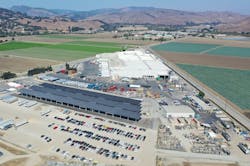More of our food is about to come from microgrid power. California’s Taylor Farms, a major North American fresh food producer, is building a microgrid in partnership with Bloom Energy, Ameresco and Concept Clean Energy.
The microgrid will be designed to power an entire 450,000 square facility, so that it eventually can operate with no tie to the grid. It will use 6 MW of Bloom fuel cells, 2 MW of solar power from Concept Clean Energy and a 2 MW/4MWh battery.
“We are looking forward to the energy stability this will provide our San Juan Bautista, California facility,” said Bruce Taylor, chairman and CEO, Taylor Farms. “Fresh food reliability is essential for our customers and it’s more critical than ever to provide quality, fresh foods to North Americans.”
A list of California food producers going microgrid
Taylor Farms follows several other California food production facilities that are adopting microgrid technology because of grid reliability issues or high grid power costs. Others are pursuing sustainability goals — agriculture is California’s fifth largest greenhouse gas emitter. Food production facilities using or building microgrids include Bimbo Bakeries USA, Domaine Carneros Winery, Bluehouse Greenhouse, and Stone Edge Farm.
Reliable power in California is particularly important to North America’s food system, given that the state produces over 1/3 of US vegetables and 2/3 of its fruits and nuts. But the state’s grid has been besieged by power issues, including ongoing public power safety shutoffs to avert wildfires and a blackout in August 2020. In addition, the state now faces a power capacity shortfall.
These problems are part of the reason that California regulators have been striving to foster the development of microgrids. California was recently ranked by Think Microgrid as a top-tier state for microgrid policy activity.
Watch representatives of California’s agricultural industry discuss food and microgrids at Microgrid California. Free replay here.
Off-grid microgrid
The microgrid is unusual in that Taylor Farms intends to use it to take its facility entirely off grid. Most North American microgrids are grid-connected, allowing them to take services or sell services to the grid as needed. However, there is a small, but seemingly growing movement among businesses and homeowners to rely solely on their microgrid or nanogrid for electric power.
The microgrid will initially be connected to the grid until the solar and battery system complete testing. Bloom Energy is handling the primary power design with Ameresco and Concept Clean Energy undertaking installation. Ameresco will incorporate the battery and solar panels into the microgrid distribution site design. Together, Ameresco and Bloom will manage the long-term operations and maintenance of the microgrid.
The fuel cells will initially operate with natural gas. But because Bloom Energy’s fuel cells are fuel flexible they can be converted to another fuel in the future, such as hydrogen, biofuel, renewable fuel or a blend of hydrogen and natural gas.
The partners broke ground on the project July 18 and expect to complete it in February 2024.
A blueprint for others?
Sharelynn Moore, Bloom Energy’s executive vice president, chief business development and marketing officer, described the project as “a landmark demonstration of the capabilities that innovative, clean energy companies have to provide uninterrupted low-carbon power to large-scale facilities.”
Michael Bakas, Ameresco executive vice president, said that the project will serve “as a blueprint for others as the role for baseload, dispatchable alternative energy sources become the cornerstone for resiliency in microgrids.”
The installation of the microgrid continues a decade-long relationship between Bloom Energy and Taylor Farms. Bloom activated a fuel cell at Taylor Farms facility in Salinas, California in 2012.
Track news about microgrids for the food industry. Subscribe to the free Microgrid Knowledge Newsletter.








